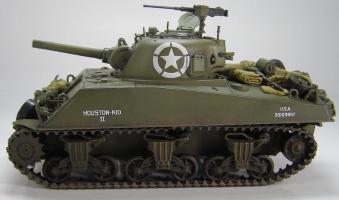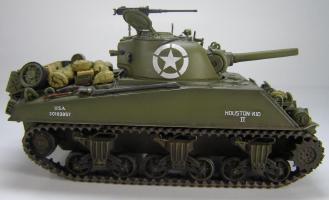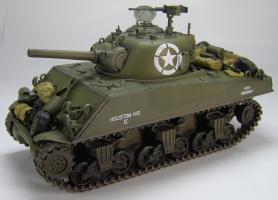Hobby Master Archive
Ground Power 1/48
Sherman
Sherman M4 105mm Howitzer 15th Tank Battalion
Hobby Master 1/48 Ground Power Series HG1002 Sherman M4 105MM Howitzer 15th Tank Battalion, “Houston Kid II”
History of the Sherman M4 105mm Howitzer The prototype of the M4 nicknamed the “General Sherman” by British troops was designated the T-6 and appeared in September 1941. This medium tank would go on to be one of the most important pieces of armor in WW II. Its production number of approximately 55,000 of all versions was only surpassed by the Soviet T-34 57,000 of all its versions. About 44,000 were armed with the 75mm Gun M3, with 6,465 76mm Gun M1, and later in the war 4,180 armed with the 105mm Howitzer M4 were introduced. At production start up 1,000 units a month came off the assembly line with that number increasing to 2,000 per month when all 11 plants were up and running. The first “Sherman” to be thrown into battle was the 75mm gun version. In one version or another the “Sherman” would see action in all theaters of operation throughout WW II. Since there wasn’t any other tank available in any great numbers the M4 was tasked to do jobs that it was never designed for. Within a year of being introduced in Europe the original version was found to be obsolete because it just couldn’t handle the battle conditions and opposition equipment. The Army and Marines realized this so in 1943 a firm commitment to “win the war” was made and the Sherman would be the vehicle to use. Major improvements were needed and they included a new 76mm main gun that had a much higher muzzle velocity than the 75mm and this greatly improved the penetrating ability of the “Sherman” shells. The other major improvement was the introduction in July 1944 of the 105mm Howitzer, it would provide heavy front line fire support for the U.S. Army and Marines as well as extensive use in anti-tank operations. The 76mm produced at the Detroit Tank Arsenal now used what was referred to as “wet” ammunition stowage. The ammunition was actually stowed in water-protected racks below the turret instead of in the sponsons. Ten boxes on the hull floor held 100 rounds and needed 37.1 gallons of water with a further gallon being needed to protect the four ready rounds. The water contained ethylene glycol to prevent freezing and a corrosion inhibiter known as “Ammudamp”. This version helped prevent internal fires and explosions when hit. This occurrence was common knowledge as the Americans' nickname for the Sherman was the ZIPPO (lights first time, every time), while the Germans called it the TOMMY COOKER. 105mm howitzer armed variants didn’t use “wet” ammunition storage they used armored racks. Floor ammunition racks required that the turret basket be eliminated with a partial floor suspended from the turret ring. The 105mm howitzer was carried in a M52 combination mount and a vision cupola was fitted for the commander with a small hatch for the loader. It could fire M1 shells at angles from -10 to +35 degrees at a maximum range of 11500m. Out of the 4,180 armed with the 105mm Howitzer M4 about 500 were produced at the Chrysler factory in Detroit from May to September 1944. Besides the increased size of the main gun the most noticeable external feature is the 47 degree front hull with a newly designed and much larger driver /assistant driver hatches. Also from September 1944 (HVSS) horizontal volute spring suspension was introduced on the M4A3 (105mm) together with the wider center-guide T66 tracks. All U.S. Army M4s were equipped with a .50cal Browning Machine Gun M2-HB in a pintle mount on the turret. The M4 105mm was a great consumer of ammunition because of its use as fire support just like regular field artillery.
Specifications for M4 Sherman 105mm Howitzer Dimensions Overall length: 6.197m Overall width: 2.67m Overall height: 2.94m Weight Weight, Combat Loaded: 31.48t Weight, Un-stowed: 28.486t Armor Actual Thickness, Angle w/Vertical Hull Thickness: Front: 63mm/47 degrees Sides: 38mm/0 degrees Rear: 38mm/10 degrees Top: 19mm/83-90 degrees Turret Thickness: Front: 76mm/30 degrees Sides: 51mm/0-5 degrees Rear: 51mm/0 degrees Top: 25.4mm/90 degrees Gun Shield: 91mm/0 degrees Armament M4 105mm howitzer (X1), M1919A4 7.62mm machine gun (X2), M2 12.7mm heavy machine gun (X1). Ammunition: 66 rounds 105mm, 4,000 rounds 7.62mm, 600 rounds 12.7mm.
Powerplant Engine: Continental R975-C4 9-cylinder 4-cycle radial air cooled (15,945cc displacement, 460hp/2,400rpm output) Maximum speed: 38.6 km/h, Cruising Range: about 161km, Crew: 5
HG1002 Sherman M4 105mm Howitzer Big, Bold and Beautiful, the only way to describe this latest creation from Hobby Master. The M4 105mm Howitzer was a notable improvement over earlier Shermans and was primarily used as a piece of field artillery, indirect fire in support of the battalion. This bad boy could fire a shot as far away as 7 miles. The entire model is crafted to the great standard we expect from Hobby Master. Wide tracks surrounding detailed wheels and suspension are the base for this splendidly painted recreation. The turret turns, main gun elevates and commander’s hatch opens. All markings are the usual high quality Hobby Master routinely delivers. With over 4,100 M4 105mm tanks made, along with its performance it has earned a well-deserved spot in the history books and your collection.
History of the 15th Tank Battalion December 16, 1944 was the beginning of what would become better known as the “Battle of the Bulge”. That day Hitler launched his ill-fated last offensive in an attempt to reach the sea and capture the port of Antwerp thereby cutting off Allied Forces re-supply, trap four allied armies and impel a negotiated peace. Three powerful German Armies launched an all out attack into the semi-mountainous, heavily forested Ardennes region of Eastern Belgium and Northern Luxembourg. This was the least protected area because the Allied Command thought it was too rugged for the Germans to mount any creditable attack, like their predecessors almost 30 years earlier, they were wrong. After Eisenhower and his advisors finally realized on December 19th that the action wasn' t just a small isolated event General Patton was ordered to go to the rescue of the trapped U.S. soldiers in Bastogne. Over 250,000 men and equipment were turned 90 degrees north from their original assignments and slipped and slid their way to save the embattled soldiers. It was the coldest winter on record for the Ardennes region and to add to the problem the weather was miserable all contributing to traction problems for the equipment along with freezing parts and was impeding their progress. The 15th was part of this massive movement that arrived in Bastogne on Dec. 26, 1944. On January 1st, 1945 the battalion was part of the force sent north to join up with the British who were going to head south and meet at Houffalize, Belgium thereby cutting off any escape route for the retreating German Army. Since there was a snow storm on the 1st and 2nd of January the British didn’t get started south until the 3rd and this gave a large number of Germans the opportunity to escape. As part of Patton’s forces the 15th TB fought their way east driving the Germans back deeper into their own territory and were involved in just about every major conflict along the way. For the period July 18, 1944 until May8, 1945 the 15th Tank Battalion received 2 Distinguished Service crosses, 1 Legion of Merit, 93 Silver Stars, 2 Service medals, 347 Bronze Stars, 161 Purple Hearts. The 15th Tank Battalion was inactivated in February 1946 only to be activated again May 1, 1947 in Italy. This was short lived when once again the 15th was inactivated December 1, 1949 in Italy. The Battalion would be activated and inactivated several more times over the years.
Authentic Detailing Pre-Painted by professionals Accurate paint colors Markings Tampo (pad) applied Fully Assembled Die-Cast Model True to Scale (1:48) Weathering and insignias Turret turns Main gun elevates Metal chassis, hull, turret and main gun Realistic tracks is only caused by converting the pictures and re-sizing them THESE ARE PRE-PRODUCTION PICTURES, NOT THE FINAL PRODUCT
| Added to archive | 2021-01-14 |
| Last modified | 2021-01-14 |




